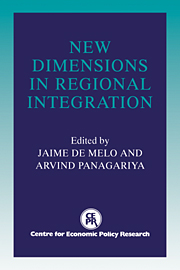Book contents
- Frontmatter
- Contents
- List of figures
- List of tables
- Preface
- Foreword
- Acknowledgements
- List of conference participants
- PART ONE SYSTEMIC ISSUES
- PART TWO COUNTRY ISSUES
- 6 The new regionalism: a country perspective
- Discussion
- 7 The European Community: a case of successful integration?
- Discussion
- 8 Regional integration in Sub-Saharan Africa: past experience and future prospects
- Discussion
- 9 Latin America's integration and the multilateral trading system
- Discussion
- 10 Regional integration in Eastern Europe: prospects for integration within the region and with the European Community
- Discussion
- 11 Regional trade arrangements in North America: CUSTA and NAFTA
- Discussion
- 12 Trading blocs and East Asia
- Discussion
- 13 Prospects for regional integration in the Middle East
- Discussion
- Round Table Discussion
- Index
Discussion
Published online by Cambridge University Press: 04 May 2010
- Frontmatter
- Contents
- List of figures
- List of tables
- Preface
- Foreword
- Acknowledgements
- List of conference participants
- PART ONE SYSTEMIC ISSUES
- PART TWO COUNTRY ISSUES
- 6 The new regionalism: a country perspective
- Discussion
- 7 The European Community: a case of successful integration?
- Discussion
- 8 Regional integration in Sub-Saharan Africa: past experience and future prospects
- Discussion
- 9 Latin America's integration and the multilateral trading system
- Discussion
- 10 Regional integration in Eastern Europe: prospects for integration within the region and with the European Community
- Discussion
- 11 Regional trade arrangements in North America: CUSTA and NAFTA
- Discussion
- 12 Trading blocs and East Asia
- Discussion
- 13 Prospects for regional integration in the Middle East
- Discussion
- Round Table Discussion
- Index
Summary
Brada has in Chapter 10 provided us with a comprehensive study. It covers East–West, West–East, East–East trade, and both disintegration and integration. It is also a pragmatic and quite sensible chapter, so that (unfortunately from the perspective of a discussant) I must admit to agreeing with a good deal of it, and to finding it very interesting. The basic thrust that CMEA was Vinerian trade-diverting (bad) but that it was viewed in Johnsonian (strategic) terms is surely right. Indeed, it would be hard to find a better example of an ‘immizerising empire’ than the Russian, with its several layers of subsidies emanating from the core – to energy-poor Soviet states, to still poorer CMEA partners (Mongolia, Cuba and North Korea) and to client developing countries. The distributional effect of these subsidies was superimposed on the systemic inefficiencies characteristic of the Soviet System. A few participants, e.g., Mongolia, may have gained in net terms; Russia – and certainly the East European countries because of their previously developed economies lost.
Brada is also surely right in concluding that the fall in CMEA trade resulted mostly from the illiquidity and collapse of the Soviet economy rather than simply the end of the CMEA trading system. But then this also implies that, despite the trade-diverting nature of the CMEA, the fall in trade does not necessarily show that the CMEA partners were unable to supply the goods needed by the ex-USSR – given the long-standing problem of dependency created in the CMEA.
- Type
- Chapter
- Information
- New Dimensions in Regional Integration , pp. 347 - 351Publisher: Cambridge University PressPrint publication year: 1993



